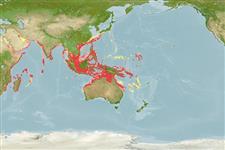Common names from other countries
>
Eupercaria/misc (Various families in series Eupercaria) >
Nemipteridae (Threadfin breams, Whiptail breams)
Etymology: Nemipterus: Greek, nema, -atos = filament + Greek, pteron = wing, fin (Ref. 45335).
More on author: Valenciennes.
Environment: milieu / climate zone / depth range / distribution range
Ecologia
marinhas; estuarina demersal; não migratória; intervalo de profundidade 17 - 100 m (Ref. 9785). Tropical; 34°N - 27°S, 31°E - 172°E (Ref. 3810)
Indo-West Pacific: from the Red Sea to Taiwan and northern Australia. This species name has been misapplied to Nemipterus furcosus.
Length at first maturity / Tamanho / Peso / Idade
Maturity: Lm 45.0 range ? - ? cm
Max length : 29.0 cm SL macho/indeterminado; (Ref. 48635); common length : 17.0 cm SL macho/indeterminado; (Ref. 3810)
Espinhos dorsais (total) : 10; Raios dorsais moles (total) : 9; Espinhos anais: 3; Raios anais moles: 7. Suborbital spine absent. Preopercle with 3 transverse scale rows. Pectoral fins short, not reaching to level of anus. Pelvic fins moderately long, reaching to level of anus. Dorsal fin spines elongate, interspinous membrane deeply incised. Upper lobe of caudal fin pointed and slightly longer than lower. A line drawn up from the posterior edge of suborbital reaching the dorsal profile at or just before origin of dorsal fin. Axillary scale present. Color: Upper part of body pinkish, lower part silvery. Golden-yellow stripe on snout in front of eye.
Occurs on sand or mud bottoms and feeds on fish, crustaceans, mollusks and polychaetes. Usually in small groups; flighty during the day (Ref. 48635). Trawled in commercial quantities in the Straits of Malacca and off the Terengganu coast, South China Sea.
Life cycle and mating behavior
Maturities | Reprodução | Spawnings | Egg(s) | Fecundities | Larvas
Two prolonged spawning seasons are likely in the South China Sea off the Trengganu coast: from November to February, and another starting in May or June. Also Ref. 103751.
Russell, B.C., 1990. FAO Species Catalogue. Vol. 12. Nemipterid fishes of the world. (Threadfin breams, whiptail breams, monocle breams, dwarf monocle breams, and coral breams). Family Nemipteridae. An annotated and illustrated catalogue of nemipterid species known to date. FAO Fish. Synop. 125(12):149p. Rome: FAO. (Ref. 3810)
Categoria na Lista Vermelha da IUCN (Ref. 130435)
CITES (Ref. 128078)
Not Evaluated
Ameaça para o homem
Harmless
Utilização humana
Pescarias: espécies comerciais
Ferramentas
Relatórios especiais
Descarregue XML
Fontes da internet
Estimates based on models
Preferred temperature (Ref.
115969): 24.1 - 28.6, mean 27.5 (based on 746 cells).
Phylogenetic diversity index (Ref.
82804): PD
50 = 0.5000 [Uniqueness, from 0.5 = low to 2.0 = high].
Bayesian length-weight: a=0.01288 (0.01053 - 0.01576), b=2.95 (2.91 - 2.99), in cm Total Length, based on LWR estimates for this species (Ref.
93245).
Nível Trófico (Ref.
69278): 3.7 ±0.3 se; based on diet studies.
Resiliência (Ref.
120179): Elevada, tempo mínimo de duplicação da população menor que 15 meses (tm=1).
Fishing Vulnerability (Ref.
59153): Low to moderate vulnerability (26 of 100).
